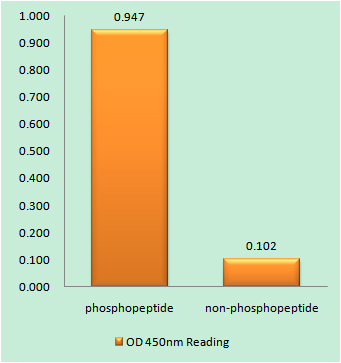Phospho AQP2 (S256) Cell-Based Colorimetric ELISA Kit
- Catalog No.:KA1021C
- Applications:ELISA
- Reactivity:Human;Mouse;Rat
- Gene Name:
- AQP2
- Human Gene Id:
- 359
- Human Swiss Prot No:
- P41181
- Mouse Swiss Prot No:
- P56402
- Rat Swiss Prot No:
- P34080
- Storage Stability:
- 2-8°C/6 months
- Other Name:
- Aquaporin-2 (AQP-2) (ADH water channel) (Aquaporin-CD) (AQP-CD) (Collecting duct water channel protein) (WCH-CD) (Water channel protein for renal collecting duct)
- Detection Method:
- Colorimetric
- Background:
- disease:Defects in AQP2 are the cause of diabetes insipidus nephrogenic autosomal (ANDI) [MIM:125800]; also known as diabetes insipidus nephrogenic type 2. ANDI is caused by the inability of the renal collecting ducts to absorb water in response to arginine vasopressin. It is characterized by excessive water drinking (polydypsia), excessive urine excretion (polyuria), persistent hypotonic urine, and hypokalemia. Inheritance can be autosomal dominant or recessive.,domain:Aquaporins contain two tandem repeats each containing three membrane-spanning domains and a pore-forming loop with the signature motif Asn-Pro-Ala (NPA).,function:Forms a water-specific channel that provides the plasma membranes of renal collecting duct with high permeability to water, thereby permitting water to move in the direction of an osmotic gradient.,online information:AQP2 pages,PTM:Ser-256 phosphorylation is necessary and sufficient for expression at the apical membrane. Endocytosis is not phosphorylation-dependent.,similarity:Belongs to the MIP/aquaporin (TC 1.A.8) family.,subcellular location:Shuttles from vesicles to the apical membrane.,tissue specificity:Expressed in renal collecting tubules.,
- Function:
- renal system process involved in regulation of blood volume, circulatory system process, renal system process, renal system process involved in regulation of systemic arterial blood pressure, regulation of systemic arterial blood pressure, renal water transport, water transport, response to osmotic stress, excretion, blood circulation, regulation of blood pressure, response to water deprivation, response to water, response to abiotic stimulus, response to salt stress, response to extracellular stimulus, cellular response to extracellular stimulus, cellular response to stress, fluid transport, cellular response to water deprivation, secretion, regulation of body fluid levels, transmembrane transport,
- Subcellular Location:
- Apical cell membrane ; Multi-pass membrane protein . Basolateral cell membrane ; Multi-pass membrane protein . Cell membrane ; Multi-pass membrane protein . Cytoplasmic vesicle membrane ; Multi-pass membrane protein . Golgi apparatus, trans-Golgi network membrane ; Multi-pass membrane protein . Shuttles from vesicles to the apical membrane (PubMed:15509592). Vasopressin-regulated phosphorylation is required for translocation to the apical cell membrane (PubMed:15509592). PLEKHA8/FAPP2 is required to transport AQP2 from the TGN to sites where AQP2 is phosphorylated (By similarity). .
- Expression:
- Expressed in collecting tubules in kidney medulla (at protein level) (PubMed:7510718). Detected in kidney (PubMed:7510718).
- June 19-2018
- WESTERN IMMUNOBLOTTING PROTOCOL
- June 19-2018
- IMMUNOHISTOCHEMISTRY-PARAFFIN PROTOCOL
- June 19-2018
- IMMUNOFLUORESCENCE PROTOCOL
- September 08-2020
- FLOW-CYTOMEYRT-PROTOCOL
- May 20-2022
- Cell-Based ELISA│解您多样本WB检测之困扰
- July 13-2018
- CELL-BASED-ELISA-PROTOCOL-FOR-ACETYL-PROTEIN
- July 13-2018
- CELL-BASED-ELISA-PROTOCOL-FOR-PHOSPHO-PROTEIN
- July 13-2018
- Antibody-FAQs


